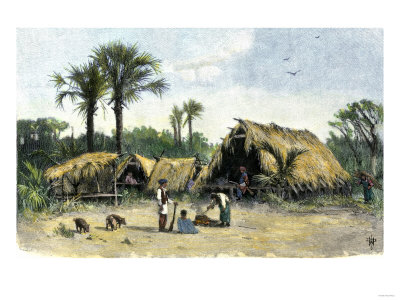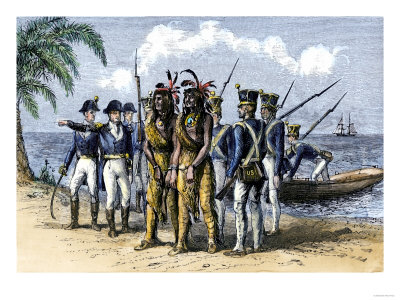Florida
° Boca Grande ° Fort Lauderdale ° Key West ° St. Augustine° Oseola and the Seminoles
Osceola
The Seminole people are the descendents of the Creek people. The diversity of the Tribe is reflected in the fact that its members spoke seven languages- Muscogee, Hitchiti, Koasati, Alabama, Natchez, Yuchi and Shawnee.

The early history of the Creek people in Florida is not well understood. The Apalache were a Hitchiti speaking people that may have been related to the Creek Tamathli or Apalachicola. The Apalache, situated along the Apalachicola River, were in Florida at the time of Spanish contact. At the beginning of the sixteenth century, the Spanish attempted to set up a system of missions across north Florida and southern Georgia. While these efforts to set up missions in the Creek country failed, there were Creeks that were drawn from Georgia down to the Spanish missions in Florida.
The first Creek speaking people, settled at Chocuchattee (Red House) near present day Brooksville, Florida. This was some time around 1760. They were also cattlemen. Soon the vast herds of the growing Seminole Nation drew the attention of their white neighbors to the north. Conflicts that were occurring in Georgia spilled into Florida due to an increased white desire for land and cattle.
Osceola or Rising Sun
Illustration from Indian Tribes of North America
George Catlin

The Seminole population in Florida remained fairly small, around 1200, compared to the main body of Creeks in Georgia and Alabama, who numbered possibly 25,000 people. Then came the War of 1812. This period of time has been divided by historians into the War of 1812 (1812-1815); the Creek War (1813-1814); the Creek Civil War (1813); the First Seminole War (1818-1819).
By 1823 the native population had increased three or four fold by the newcomers. This population of about five thousand was thrown together and subjected to the fiercest of all the wars ever waged by the U.S. Government against native peoples when, in 1830, the U. S. government attempted to relocate Seminoles to Oklahoma, causing the Second Seminole War, 1835-1842. By the end of the war there were reportedly only three-hundred Seminoles left in the territory. Then they fought the Third Seminole War and removed another 240 or so Seminoles. In reality, all of these conflicts were one long war against the Creeks.
When Seminole leader Oseola was captured by the U.S. in 1837, U.S. troops said they wanted to talk about truce. After decades of strife, 200 to 300 Seminoles remained hidden in Florida's swamps.
March 22, 1837, Belmont Gazette, Belmont, Wisconsin
SURRENDER OF OSEOLA
The last news from the South, is of such a character, as to leave but little doubt that the Seminole campaign has at last been brought to a close. Oseola has surrendered himself to Gen. Jesup, together with three hundred warriors. The great chief, says the account, formed his men into line -- leaned himself against a tree-and when the U.S. officer who was despatched to receive him came up, he approached him, and gave up his rifle, with all the grace of a fallen hero.
Seminole Reservation and Villages. 1844.

As a territory of the United States, Florida was particularly attractive to people from the older Southern plantation areas of Virginia, the Carolinas, and Georgia, who arrived in considerable numbers. After territorial status was granted, the two Floridas were merged into one entity with a new capital city in Tallahassee. Established in 1824, Tallahassee was chosen because it was halfway between the existing governmental centers of St. Augustine and Pensacola.
June 1, 1886, Daily Alta California, San Francisco. USA
FLORIDA INDIAN WARFARE.
Osceola, the Famous Chief, Once a Prisoner in Fort Marion
From the St. Auiastine, Fin., Weekly.
 |
| Seminole Village of Thatched Shelters. c. 1800s |
J. William Kendrick of Jacksonville is sixty-two years of age and was born and reared in Florida. His birthplace was on the Suwanee river, within a mile of where the great Indian Chief Osceola was born and lived. He contends that the great chief whipped the United States Government in every battle he fought during the Florida Indian war. He regards Osceola the equal, if not the superior, of Napoleon or any other of the great Generals of hie day in strategy and prowess.
He was a half-breed. His father was a man from Georgia by the name of Powell. The great chief was known by the name of Powell until the day of the meeting at Fort King for the purpose of signing the treaty with Thompson, the United States Commissioner, to transfer their lands and move to Indian Territory. When the great chief, or king, of tbe tribe bad signed the treaty, followed by all the sub-chiefs, Powall was asked to affix his name, as be was regarded aa a subchief, or an Indian of distinction, for his prowess in the hunt, as well as his bravery and inflnence with the tribe, and his fine personal appearance. When called by the Commissioner, Powell came forward, took the pen, threw it to the ground, drew his hunting-knife and plunged it into the heart of the great chief of the nation, and then turning in the twinkling of an eye buried it in the heart of the United States Commissioner.
The sub-chiefs were as greatly surprised at Oceola's act as were the United States authorities present. Powell had taken the precaation to have in striking distance several hundred of the bravest warriors of the tribe, who, upon a signal, made their appearance, and as he walked out of the tent mutilated it with the same knife that he had taken the lives of the two principal actors in projecting tbe treaty. His braves met him and consequently declared him Osceola, the great chief of the Seminolee.
Seminole Indians Ambush a US Marine Supply Wagon.
September 11, 1812
C. H. Waterhouse

Kendrick told me at this time Osceola was only 22 years of age. He contends that the Indian has always been misrepresented; instead ot being the savage beast that he has always been represented to be, he was always kind to his prisoners, and prevented to the extent he conld, the scalping and mutilation of the dead and the making of war on women and children. As an evidence of his friendly disposition to the whites, Mr. Kendrick says that after he had assassinated the two principal actors in the signing of the treaty, he would not permit the warriors to molest the garrison of United States troops, who were wholly in his power, but said to them on his departure, "Leave me and my people to the wilds of my country, and you will never have to complain of Osceola and his people; but if you attempt to hunt as down and capture as by force, we will fight you to the bitter end."
Another evidence of the, humanity of Osceola was shown in the massacre of Major Dade and his command. Dade was sent with a detachment from Fort King against the Indians, and to open communication between Fort King and Tampa, on the Gulf Coast. He was a man greatly loved by Osceola, as they had often been on the hunt together. Osceola attempted to evade the contest, even to the extent of arousing the suspicion of his loyalty to the tribe. When he ordered the attack on the detachment commanded by Major Dade, in the commencement of the battle, he raised his gun and said to one of his chiefs:
"I am now going to kill one of my best friends, and a man I love."
 |
| Capture of Seminole Chiefs in Florida during the Seminole Wars |
At the crack of his rifle Major Dade fell dead, and Oeceola threw down his gnn and never fired another shot during the remainder of the engagement. Another evidence of his disposition to conduct a civilized warfare was the fact that when the last United States soldier was shot down, as none proposed to surrender, the carnage ceased and not a soldier was scalped, and it is also a fact undisputed that several days after the engagement, when a detachment from Fort King went to the battlefield to bury the dead, not a body had been mutilated, and, farther, that $4,000 in gold and silver was removed from the pockets of the dead. Where will you find a like occurrence on any battlefield in our Civil War?

It is said that Osceola became alarmed at the close of the battle and retreated rapidly, but it is on record that he did not leave the battlefield until he disposed of all the implements of war and transportation, sinking tbe wagons and cannon-carriages in a quicksand lake near the battlefield, so if they had time for this work they certainly had time to scalp and rifle the pockets of the dead on tbe battlefield.
Mr. Kendrick affirms that the capture of Osceola under the white flag and his incarceration in prison at Sullivan's Island will remain a dark spot on the escutcheon of the United States. After his capture Osceola said to his captors that he had during the war in Florida tried to conduct it upon the principles of civilized warfare. He said he had never made war upon women and children, but said; "Now that you have made me a prisoner, I advise yon to look out for the safety of yonr women and children."
1899. World's Fleet. Boston Daily Globe
Lloyds Register of Shipping gives the entire fleet of the world as 28,180 steamers and sailing vessels, with a total tonnage of 27,673,628, of which 39 perent are British.
| Great Britain | 10,990 vessels, total tonnage of 10,792,714 |
| United States | 3,010 vessels, total tonnage of 2,405,887 |
| Norway | 2,528 vessels, tonnage of 1,604,230 |
| Germany | 1,676 vessels, with a tonnage of 2,453,334, in which are included her particularly large ships. |
| Sweden | 1,408 vessels with a tonnage of 643, 527 |
| Italy | 1,150 vessels |
| France | 1,182 vessels |
For Historical Comparison
Top 10 Maritime Nations Ranked by Value (2017)
| Country | # of Vessels | Gross Tonnage (m) |
Total Value (USDbn) |
|
|---|---|---|---|---|
| 1 | Greece | 4,453 | 206.47 | $88.0 |
| 2 | Japan | 4,317 | 150.26 | $79.8 |
| 3 | China | 4,938 | 159.71 | $71.7 |
| 4 | USA | 2,399 | 55.92 | $46.5 |
| 5 | Singapore | 2,662 | 64.03 | $41.7 |
| 6 | Norway | 1,668 | 39.68 | $41.1 |
| 7 | Germany | 2,923 | 81.17 | $30.3 |
| 8 | UK | 883 | 28.78 | $24.3 |
| 9 | Denmark | 1,040 | 36.17 | $23.4 |
| 10 | South Korea | 1,484 | 49.88 | $20.1 |
| Total | 26,767 | 87.21 | $466.9 | |











 Copyright ~ 1998-2018.
Copyright ~ 1998-2018. 